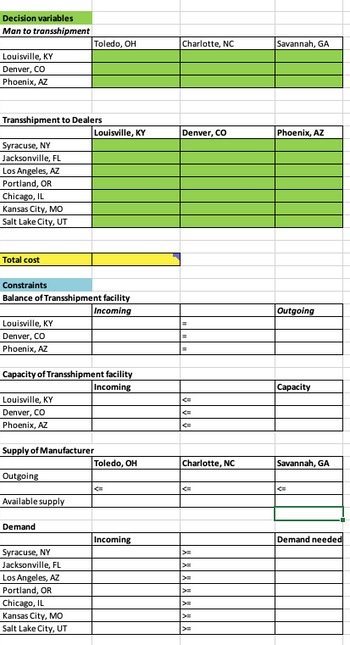Cars-to-Dealers Logistics Inc. is the exclusive logistics provider for the Summit Motor Co. and has responsibility for transporting cars from Summit’s 3 manufacturing plants in Toledo, OH; Charlotte, NC and Savannah, GA to the 7 regional dealer locations as in the tables provided in your dataset. To do this, Cars-to-Dealers uses three transshipment facilities and all cars in the distribution network pass through these transshipment facilities. Dataset also contains the information about the capacities of each of these transshipment facilities, the demand requirement at each of the regional dealer locations and the unit cost to ship one car between the various locations. In addition to supply of cars (manufacturers) and demand for cars (dealers) there are two types of constraints for each transshipment facility: 1. Balance flow constraints: dictate that all cars flowing into a transshipment facility should also flow out of the transshipment facility – i.e. no inventory of cars should remain at any of the transshipment facilities. Inflow=Outflow or Inflow-Outflow=0. In other words, sum of what quantities going in should be equal to sum of what quantities going out for each transshipment facility. 2. Capacity constraint: Above constraint does not account for capacity of each Transshipment facility. For example, what is going can be equal to what is going out in Louisville facility, but total cars going through (sum of inflows) should not exceed the capacity of Louisville. Formulate the problem as a linear program to determine how the cars should be distributed in order to minimize the distribution costs Answer parts a through c.
Cars-to-Dealers Logistics Inc. is the exclusive logistics provider for the Summit Motor Co. and has responsibility
for transporting cars from Summit’s 3 manufacturing plants in Toledo, OH; Charlotte, NC and Savannah, GA to
the 7 regional dealer locations as in the tables provided in your dataset. To do this, Cars-to-Dealers uses three
transshipment facilities and all cars in the distribution network pass through these transshipment facilities.
Dataset also contains the information about the capacities of each of these transshipment facilities, the demand
requirement at each of the regional dealer locations and the unit cost to ship one car between the various
locations.
In addition to supply of cars (manufacturers) and demand for cars (dealers) there are two types of constraints
for each transshipment facility:
1. Balance flow constraints: dictate that all cars flowing into a transshipment facility should also flow out of the
transshipment facility – i.e. no inventory of cars should remain at any of the transshipment facilities.
Inflow=Outflow or Inflow-Outflow=0. In other words, sum of what quantities going in should be equal
to sum of what quantities going out for each transshipment facility.
2. Capacity constraint: Above constraint does not account for capacity of each Transshipment facility. For
example, what is going can be equal to what is going out in Louisville facility, but total cars going
through (sum of inflows) should not exceed the capacity of Louisville.
Formulate the problem as a linear program to determine how the cars should be distributed in order to
minimize the distribution costs
Answer parts a through c.


Trending now
This is a popular solution!
Step by step
Solved in 7 steps with 13 images

Using the same data, insert the values using this format to find the same answer









